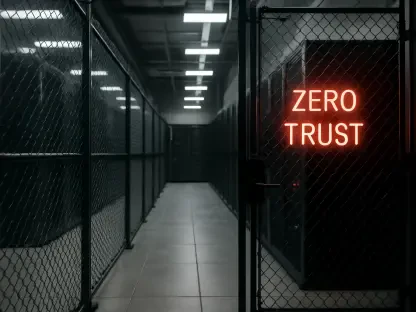In an era where cyber threats are becoming increasingly sophisticated, businesses of all sizes face the daunting challenge of protecting their digital assets from relentless attacks that can compromise data and disrupt operations. The rise of remote work, distributed networks, and cloud-based systems has only amplified these risks, leaving organizations scrambling for robust solutions that can keep pace with an ever-evolving threat landscape. Enter SonicWall, a leading name in cybersecurity, which has recently unveiled a transformative update to its product lineup with the introduction of the Generation 8 firewall platform. This launch marks a significant milestone in the industry, offering a suite of nine high-performance firewalls designed to address modern security challenges. With advanced features and a strategic focus on empowering partners, this platform promises to reshape how businesses and service providers approach cybersecurity, setting a new standard for integrated protection.
Unveiling the Power of Generation 8 Firewalls
The release of SonicWall’s Generation 8 firewall platform introduces a comprehensive range of models tailored to diverse organizational needs, from small offices to mid-sized enterprises. Spanning from the compact TZ280 for smaller setups to the robust NSa 5800 for distributed environments, these firewalls are engineered to deliver top-tier performance without compromising on security. A standout aspect of this lineup is the integration of cloud-native management capabilities, which streamline operations for Managed Service Providers (MSPs) and Managed Security Service Providers (MSSPs). Coupled with the latest SonicOS features, these devices ensure that businesses can deploy cutting-edge protection seamlessly. Additionally, built-in Zero Trust Network Access (ZTNA) capabilities reflect a forward-thinking approach to securing remote and hybrid workforces, addressing one of the most pressing concerns in today’s digital landscape. This blend of scalability and innovation positions the platform as a versatile solution for a wide array of use cases.
Beyond hardware, the Generation 8 firewalls come with flexible purchasing and subscription options that cater to varying business models. The Managed Protection Security Suite (MPSS) offers co-managed services, while the Advanced Protection Service Suite (APSS) supports self-managed environments, both available without rigid commitments or minimums. This adaptability not only helps partners build predictable revenue streams but also ensures that clients receive tailored security solutions that align with their specific requirements. SonicWall’s emphasis on enabling MSPs and MSSPs to enhance client protection is evident in these offerings, which are designed to foster growth and trust. Furthermore, the inclusion of a unique built-in cyber warranty adds an extra layer of reassurance, demonstrating a commitment to standing behind the product’s reliability. Such features underscore how this platform reimagines the role of firewalls as comprehensive security tools rather than mere network barriers.
Empowering Partners in a Dynamic Threat Landscape
A key pillar of SonicWall’s strategy with the Generation 8 launch is its dedication to transforming partners from traditional resellers into high-value security providers. By offering flexible licensing and co-managed services through initiatives like the SonicSentry team, the company equips partners with the tools needed to differentiate their offerings and boost profit margins. This shift is particularly significant for small and medium-sized businesses (SMBs) and mid-market enterprises, where tailored security solutions can make a substantial difference. The platform also supports multi-tenant management and compliance-focused reporting, addressing critical needs in regulated industries. Such capabilities allow partners to deliver specialized services that resonate with clients facing unique challenges, thereby strengthening relationships and fostering loyalty in a competitive market. This partner-centric approach reflects a deep understanding of the evolving role of service providers in cybersecurity.
Another innovative element of this launch is the optional cyber insurance coverage of up to $1 million, which provides financial protection for clients in the event of a breach. This feature not only enhances customer confidence but also positions partners as trusted advisors who can offer holistic solutions beyond technical safeguards. By integrating hardware, software, services, and third-party collaborations, SonicWall creates a unified security ecosystem that adapts to modern demands like remote work and distributed networks. This holistic strategy aligns with industry trends emphasizing scalable, integrated solutions over fragmented approaches. The focus on empowering partners with such comprehensive tools ensures that they are well-prepared to tackle the complexities of today’s cyber threats, ultimately benefiting end-users with robust, reliable protection. This model sets a benchmark for how cybersecurity vendors can drive value through collaboration and innovation.
Reflecting on a Bold Step Forward
Looking back, SonicWall’s rollout of the Generation 8 firewall platform stood as a defining moment in the cybersecurity realm, showcasing a blend of cutting-edge technology and strategic foresight. The introduction of nine diverse models, paired with advanced features like ZTNA and unified management, addressed critical gaps in protection for businesses navigating a complex digital environment. The emphasis on partner empowerment through flexible services and financial safeguards like cyber warranties marked a shift toward a more collaborative and comprehensive approach to security. As organizations reflected on their next moves, the path forward involved leveraging these tools to build resilient defenses, with partners playing a pivotal role in customizing solutions to specific needs. Exploring subscription models like MPSS or APSS offered a way to align security with budget constraints, while staying vigilant about emerging threats remained essential. This launch paved the way for a future where integrated, adaptable cybersecurity became the norm, equipping all stakeholders to face challenges with confidence.









